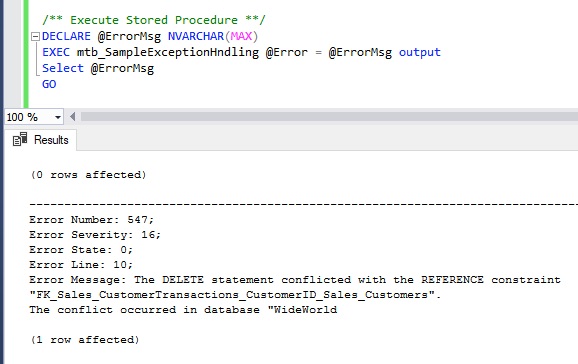In my earlier article, we have seen how to capture and return the error messages from stored procedures. Now we will see how to implement transaction along with exception handling. In any transaction scenario, we have to rollback transaction on error in SQL execution. Using TRY-CATCH we can capture the exception occurred in a statement in the stored procedure and in the CATCH block we can rollback the transaction. Below is an example. In this example, In the CATCH block after capturing the error details, we can place the ROLLBACK TRANSACTION.
Example
Use WideWorldImporters GO /** Create Stored procedure **/ CREATE PROCEDURE mtb_SampleExceptionHndling @Error NVARCHAR(MAX) OUTPUT AS BEGIN BEGIN TRANSACTION; BEGIN TRY DELETE FROM Sales.Customers WHERE CustomerID = 1 END TRY BEGIN CATCH SET @Error = 'Error Number: ' + CAST(ERROR_NUMBER() AS VARCHAR(10)) + '; ' + Char(10) + 'Error Severity: ' + CAST(ERROR_SEVERITY() AS VARCHAR(10)) + '; ' + Char(10) + 'Error State: ' + CAST(ERROR_STATE() AS VARCHAR(10)) + '; ' + Char(10) + 'Error Line: ' + CAST(ERROR_LINE() AS VARCHAR(10)) + '; ' + Char(10) + 'Error Message: ' + ERROR_MESSAGE() IF @@TRANCOUNT > 0 ROLLBACK TRANSACTION; END CATCH IF @@TRANCOUNT > 0 COMMIT TRANSACTION; END GO /** Execute Stored Procedure **/ DECLARE @ErrorMsg NVARCHAR(MAX) EXEC mtb_SampleExceptionHndling @Error = @ErrorMsg output Select @ErrorMsg GO /** Result **/ ----------- (0 rows affected) ----------- Error Number: 547; Error Severity: 16; Error State: 0; Error Line: 10; Error Message: The DELETE statement conflicted with the REFERENCE constraint "FK_Sales_CustomerTransactions_CustomerID_Sales_Customers". The conflict occurred in database "WideWorld (1 row affected)

Reference
- About TRY-CATCH, and implementing transaction in stored procedure at Microsoft Docs.

If @@TRANCOUNT= 0, won’t this leave an open transaction hanging about?
Can’t you just always rollback when an exception is thrown? How much overhead is there in rolling back a transaction that changed nothing?
Shouldn’t the commit go at the end of the try block? How much overhead is there in committing a transaction that changed nothing?